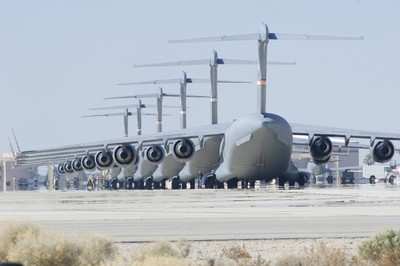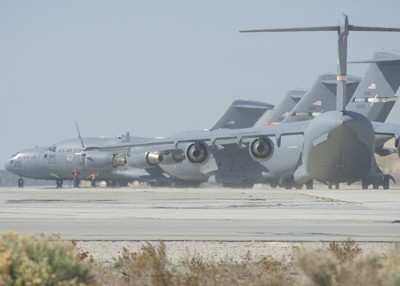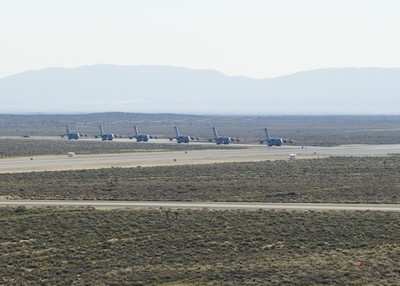Herding Globemasters Isn't Easy...
The Global Reach Combined Test Force concluded a colossal
mission of performing a formation test with six C-17 Globemaster
IIIs March 14 and 17 at California's Edwards Air Force Base.

As the newest, most flexible cargo aircraft to enter the airlift
fleet, the C-17 is capable of rapid strategic delivery of troops
and cargo to main operating bases or directly to forward bases in
deployed environments. The aircraft is equipped with a formation
flight system that enables the pilot to monitor and fly the
aircraft in formation with other C-17s.
"The C-17 has a basic mission requirement to be able to fly
large-scale formation, both in the clear and through the clouds,"
said Lt. Col. James Hanley, 418th Flight Test Squadron commander.
"The purpose is to be able to deliver a sizeable Army force of both
personnel and their equipment into a hostile environment very
rapidly."
Initially, the formation flight system was tested at Edwards in
the summer 2008, followed by another test at Pope Air Force Base,
NC in four-ship formation. "While we were there, we discovered
several system deficiencies that caused us not to recommend the
system for the next phase of operational testing," Hanley said.
One of these deficiencies included electronic interference on
the formation flight system's ability to "see" other aircraft.
"We didn't know the source," the colonel said. "Both the Systems
Group, Program Office and Boeing engineers have been analyzing the
test for the last six months. They needed some more data on what
was causing these issues. They asked the Global Reach CTF to
perform six-ship testing to gather data and hopefully, resolve
these issues. The thought-process was the more aircraft there are
in the formation, the more demand you are putting on the system and
the more chances you will be able to see these deficiencies. "

Through the formation testing, the Global Reach CTF was trying
to figure out the root cause of the system deficiencies.
"For a test of this scale, there is a lot of planning involved,"
said Colonel Hanley. "The specific formation geometries for the
test and what airplane needs to be in what position require a very
detailed plan in both how we are going to taxi and take off with
six C-17s."
The test team performed a planning process, including forming a
test and safety plan and programmatic scheduling for the
aircraft.
"Imagine driving a big rig truck that is 10 miles long; you have
to think about what you are going to do before you do it," said
Maj. Mark Jones Jr., 418th FLTS experimental test pilot. "When we
were performing the test, we had 10 miles long formation. It takes
a lot of forethought and planning to figure out how we are going to
fly and how we are going to move the airplanes around in different
formation geometries."
Part of the testing also included simulating airdrops and
finding out what happens when the aircraft formation goes through a
cloud.
"There were also a couple of challenges in dealing with six
C-17s," Jones said. "It is not like the Thunderbirds where they
take off right next to each other. When C-17 aircraft take off,
they start to get stretched out. We also have to plan our route of
flight, speed and climb schedule to make it easy for the last
aircraft to catch up with the formation."
During testing, the pilots used the formation flight system to
communicate with each other using their Global Positioning System
and Traffic Collision Avoidance Systems. The pilots monitored each
aircraft system to ensure they were working correctly.
"The lead pilot was responsible for sending information
electronically, through the system, to other C-17s so that the
whole formation knows what's going on," Jones said. "Our mission
was to collect data. Test engineers wanted to see when the system
malfunctioned. They wanted to find out when other aircraft systems
interfered with the operation of the formation flight system."
According to Jones, the system will provide a substantial
increase in capability once it becomes operational.
"The formation flight system is head and shoulders above the
C-17's legacy formation system, which is called Station Keeping
Equipment," the major said. "If we get it up and running, it is
going to streamline how we do formation and increase our
capabilities. It will make flying in formation easier for the
pilots, thereby increasing airdrops and supplies to
warfighters."

Colonel Hanley said various organizations were critical in
completing the C-17 formation flight system testing.
"Without great teamwork, we couldn't have done it," he said.
"This is overall a phenomenal effort from the whole team. We were
able to fly all these aircraft on time and get the data we needed
in two missions. The professionalism of the aircrew is remarkable.
It was an overall incredible effort, and I was proud to be part of
it."
(Aero-News thanks Senior Airman Julius Delos Reyes, 95th Air
Base Wing Public Affairs)
 ANN's Daily Aero-Linx (04.16.24)
ANN's Daily Aero-Linx (04.16.24) Aero-News: Quote of the Day (04.16.24)
Aero-News: Quote of the Day (04.16.24) Airborne 04.10.24: SnF24!, A50 Heritage Reveal, HeliCycle!, Montaer MC-01
Airborne 04.10.24: SnF24!, A50 Heritage Reveal, HeliCycle!, Montaer MC-01 Airborne 04.12.24: SnF24!, G100UL Is Here, Holy Micro, Plane Tags
Airborne 04.12.24: SnF24!, G100UL Is Here, Holy Micro, Plane Tags Airborne-Flight Training 04.17.24: Feds Need Controllers, Spirit Delay, Redbird
Airborne-Flight Training 04.17.24: Feds Need Controllers, Spirit Delay, Redbird





